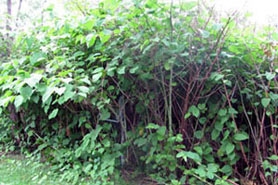Bohemian knotweed
(Fallopia x bohemicum or F. x bohemica or Polygonum x bohemicum)
Bohemian knotweed is a hybrid between Japanese knotweed (Fallopia cuspidatum; restricted) and giant knotweed (Fallopia sachalinense; prohibited).
They are herbaceous perennials that form large colonies of erect, arching stems (resembling bamboo). Stems are round, smooth and hollow with reddish-brown blotches. Plants reach up to 15’ and the dead stalks remain standing through the winter.
Other names for this plant include:
- Common names: Japanese bamboo, Mexican bamboo, fleece flower
- Scientific names: Fallopia japonica, Polygonum japonica, Polygonum reynoutria, Reynoutria japonica
Classification in Wisconsin: Prohibited
- Ecological Threat
-
- New infestations of knotweed often occur when soil contaminated with rhizomes is transported or when rhizomes are washed downstream during flooding.
- It poses a significant threat to riparian areas where it prevents streamside tree regeneration and increases soil erosion.
- Root fragments as small as a couple of inches can resprout, producing new infestations.
- Disrupts nutrient cycling in forested riparian areas.
- Plants contain allelopathic compounds (chemicals toxic to surrounding vegetation).
- Identification
-
Leaves: Simple, alternate, 3-4” wide and 4-6” long. Leaves are spade-shaped and more heart-shaped on young shoots. They have long petioles that are broad at the base and narrow to a fine point. The upper surface is dark green while the lower surface is pale green.
Flowers: Creamy white or greenish; tiny 0.125” wide; borne in plume-like clusters in upper leaf axils near the end of stems. Bloom August through September.
Fruits & seeds: Seeds are small, triangular, shiny, and black and produced by female plants; rare since colonies seldom have both male and female plants. The seed is enclosed in a winged calyx that contributes to its buoyancy. The seeds have no dormancy requirement and germinate readily. Seeds are not always produced in hybrids.
Roots: Roots are white and present along the rhizome. Plants can also produce adventitious roots on lower stems. Roots extend deeply into the soil creating a dense impenetrable mat.
Similar species: It has hollow stems with distinct raised nodes that give it the appearance of bamboo, though it is not related. Bohemian knotweed morphology can be varied, resembling either parent to a degree across a spectrum. The best way to tell them apart is by their leaf bases, Japanese knotweed is squared off while giant knotweed ((Polygonum sachalinense) is heart-shaped and with much larger leaves.
- Control
- Mechanical:
- Hand-pull young plants; dig or till when soil is soft. Plants should be pulled up by the root crown, trying to remove as much of the rhizomes as possible because any rhizomes remaining in the soil will produce new plants at each node.
- It is possible to eradicate small patches of knotweed with repeated and persistent cutting of the plants.
- Cover populations with black landscape fabric for a minimum of two growing seasons.
- Properly dispose of plant debris; fragments as small as a couple of inches can resprout, producing new infestations.
- Plants are more susceptible to herbicides if they are cut when 4-5’ tall and the regrowth treated around 3’ tall.
- Foliar application of glyphosate with a surfactant, triclopyr formulated for use with water, dicamba or imazapyr may be effective on large populations.
- Tests involving large-bore needle injection of glyphosate into the lower nodes of each stem have been successful.
For more information on control techniques, visit the Japanese knotweed factsheet [exit DNR] by the University of Wisconsin-Extension.
- Resources
- Sources for content:
- Czarapata, Elizabeth; Invasive Plants of the Upper Midwest: an illustrated guide to their identification and control. University of Wisconsin Press. 2005. Pg. 73-75
- Stone, Katharine R. 2010. Polygonum sachalinense, P. cuspidatum, P. × bohemicum. In: Fire Effects Information System, [Online]. U.S. Department of Agriculture, Forest Service, Rocky Mountain Research Station, Fire Sciences Laboratory (Producer). Available: http://www.fs.fed.us/database/feis/ [2013, Sept. 23].
- Invasive Plant Atlas of New England
- University of Wisconsin Extension - Weed Science
- King County Noxious Weeds
- WI DNR Knotweed Information [PDF]
- USDA PLANTS Profile [exit DNR]
- University of Wisconsin-Extension [exit DNR]
- Invasive.org [exit DNR]
- Wisconsin State Herbarium [exit DNR]
- King County Noxious Weeds [exit DNR]
- TechLine Invasive Plant News; Identification and Management of Invasive Knotweeds [exit DNR]


